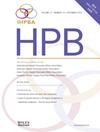Financial toxicity in patients followed for branch-duct intraductal papillary mucinous neoplasms: the risk that arises from “too much” for nothing
IF 2.4
3区 医学
Q2 GASTROENTEROLOGY & HEPATOLOGY
引用次数: 0
Abstract
Background
No data exist about financial toxicity (FT) for branch duct intraductal papillary mucinous neoplasms (BD-IPMNs).
Methods
This prospective study analyzed patients with BD-IPMNs from 2023 to 2024. Demographics, clinical data of interest, and radiological and endoscopic information were recorded for each patient. The “Comprehensive Score for Financial Toxicity” (COST) patient-reported outcome measure was used to assess financial toxicity (FT). Lower COST values indicate greater FT. A multilevel, multivariate mixed-effects model was employed.
Results
One hundred sixteen patients were interviewed during routine outpatient follow-up visits. Eighty patients agreed to complete the survey (68.9 %). The COST score was 18 (15–21, IQR), showing a fairly normal distribution (Shapiro–Wilk p = 0.054). The older the age at diagnosis, the greater the perception of FT (p < 0.001). As educational status increased, the FT burden also increased (−1.4 ± 0.6; p = 0.047). Private/self-employed patients (−3.7 ± 1.3; p = 0.004) and unemployed patients (−2.3 ± 1.0; p = 0.016) reported a higher perception of FT compared to pensioners or publicly employed individuals. WFs increase FT (−1.9 ± 0.8; p = 0.014). The longer the follow-up duration, the greater the FT (−0.3 ± 0.1; p = 0.043).
Conclusion
FT can be seen in the BD-IPMN population. The patient’s perspective must be taken into account during follow-up.
支管导管内乳头状黏液性肿瘤患者的财务毒性:因“过多”而产生的风险。
背景:目前尚无分支导管导管内乳头状黏液性肿瘤(BD-IPMNs)的财务毒性(FT)数据。方法:本前瞻性研究分析了2023年至2024年BD-IPMNs患者。记录每位患者的人口统计学、临床数据、放射学和内窥镜信息。“财务毒性综合评分”(COST)患者报告的结果测量用于评估财务毒性(FT)。成本值越低表明FT越大。采用了多水平、多变量混合效应模型。结果:在常规门诊随访中随访了116例患者。80例患者同意完成调查(68.9%)。COST得分为18 (15-21,IQR),符合正态分布(Shapiro-Wilk p = 0.054)。诊断年龄越大,对FT的感知程度越高(p < 0.001)。随着受教育程度的提高,FT负担也随之增加(-1.4±0.6;P = 0.047)。私人/个体户患者(-3.7±1.3;P = 0.004)和失业患者(-2.3±1.0;p = 0.016)报告说,与退休人员或公共雇员相比,他们对金融时报的看法更高。WFs增加FT(-1.9±0.8);P = 0.014)。随访时间越长,FT越大(-0.3±0.1;P = 0.043)。结论:在BD-IPMN人群中可见FT。随访时必须考虑患者的观点。
本文章由计算机程序翻译,如有差异,请以英文原文为准。
求助全文
约1分钟内获得全文
求助全文
来源期刊

Hpb
GASTROENTEROLOGY & HEPATOLOGY-SURGERY
CiteScore
5.60
自引率
3.40%
发文量
244
审稿时长
57 days
期刊介绍:
HPB is an international forum for clinical, scientific and educational communication.
Twelve issues a year bring the reader leading articles, expert reviews, original articles, images, editorials, and reader correspondence encompassing all aspects of benign and malignant hepatobiliary disease and its management. HPB features relevant aspects of clinical and translational research and practice.
Specific areas of interest include HPB diseases encountered globally by clinical practitioners in this specialist field of gastrointestinal surgery. The journal addresses the challenges faced in the management of cancer involving the liver, biliary system and pancreas. While surgical oncology represents a large part of HPB practice, submission of manuscripts relating to liver and pancreas transplantation, the treatment of benign conditions such as acute and chronic pancreatitis, and those relating to hepatobiliary infection and inflammation are also welcomed. There will be a focus on developing a multidisciplinary approach to diagnosis and treatment with endoscopic and laparoscopic approaches, radiological interventions and surgical techniques being strongly represented. HPB welcomes submission of manuscripts in all these areas and in scientific focused research that has clear clinical relevance to HPB surgical practice.
HPB aims to help its readers - surgeons, physicians, radiologists and basic scientists - to develop their knowledge and practice. HPB will be of interest to specialists involved in the management of hepatobiliary and pancreatic disease however will also inform those working in related fields.
Abstracted and Indexed in:
MEDLINE®
EMBASE
PubMed
Science Citation Index Expanded
Academic Search (EBSCO)
HPB is owned by the International Hepato-Pancreato-Biliary Association (IHPBA) and is also the official Journal of the American Hepato-Pancreato-Biliary Association (AHPBA), the Asian-Pacific Hepato Pancreatic Biliary Association (A-PHPBA) and the European-African Hepato-Pancreatic Biliary Association (E-AHPBA).
 求助内容:
求助内容: 应助结果提醒方式:
应助结果提醒方式:


